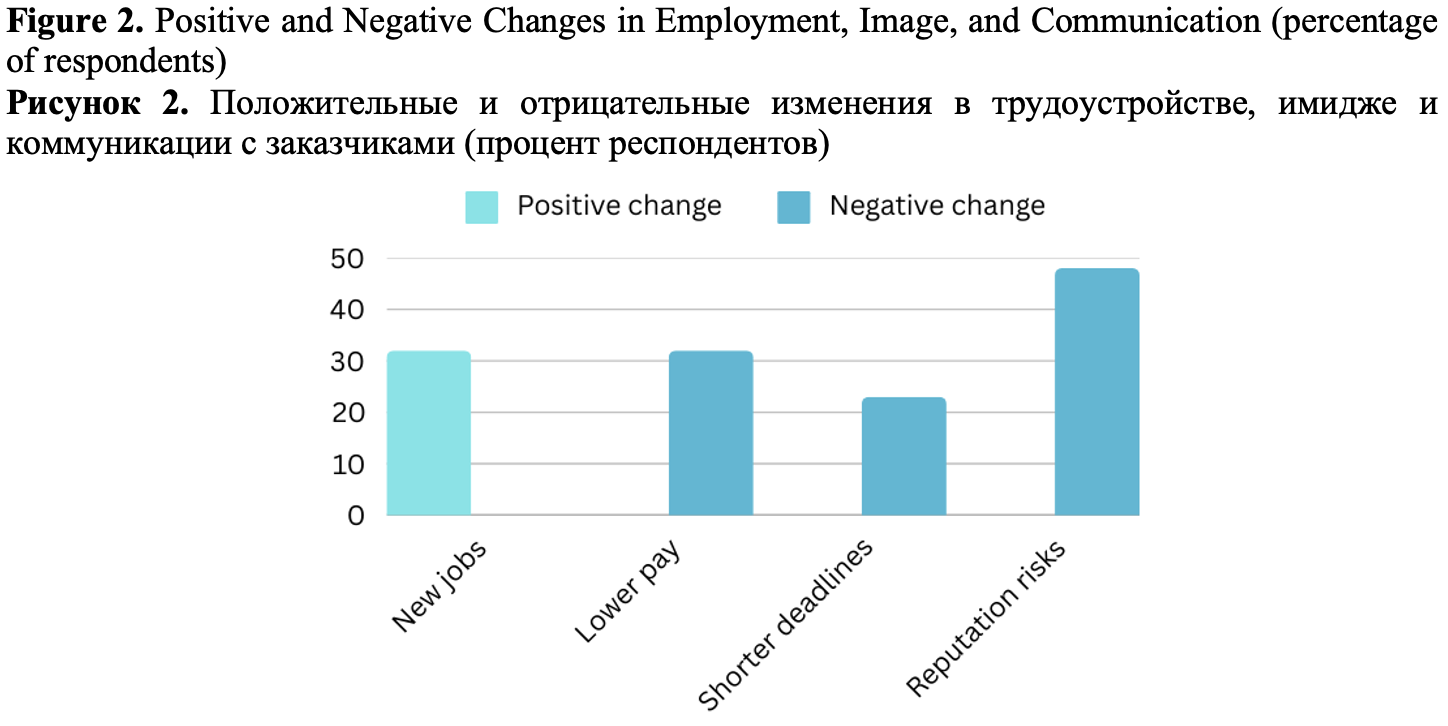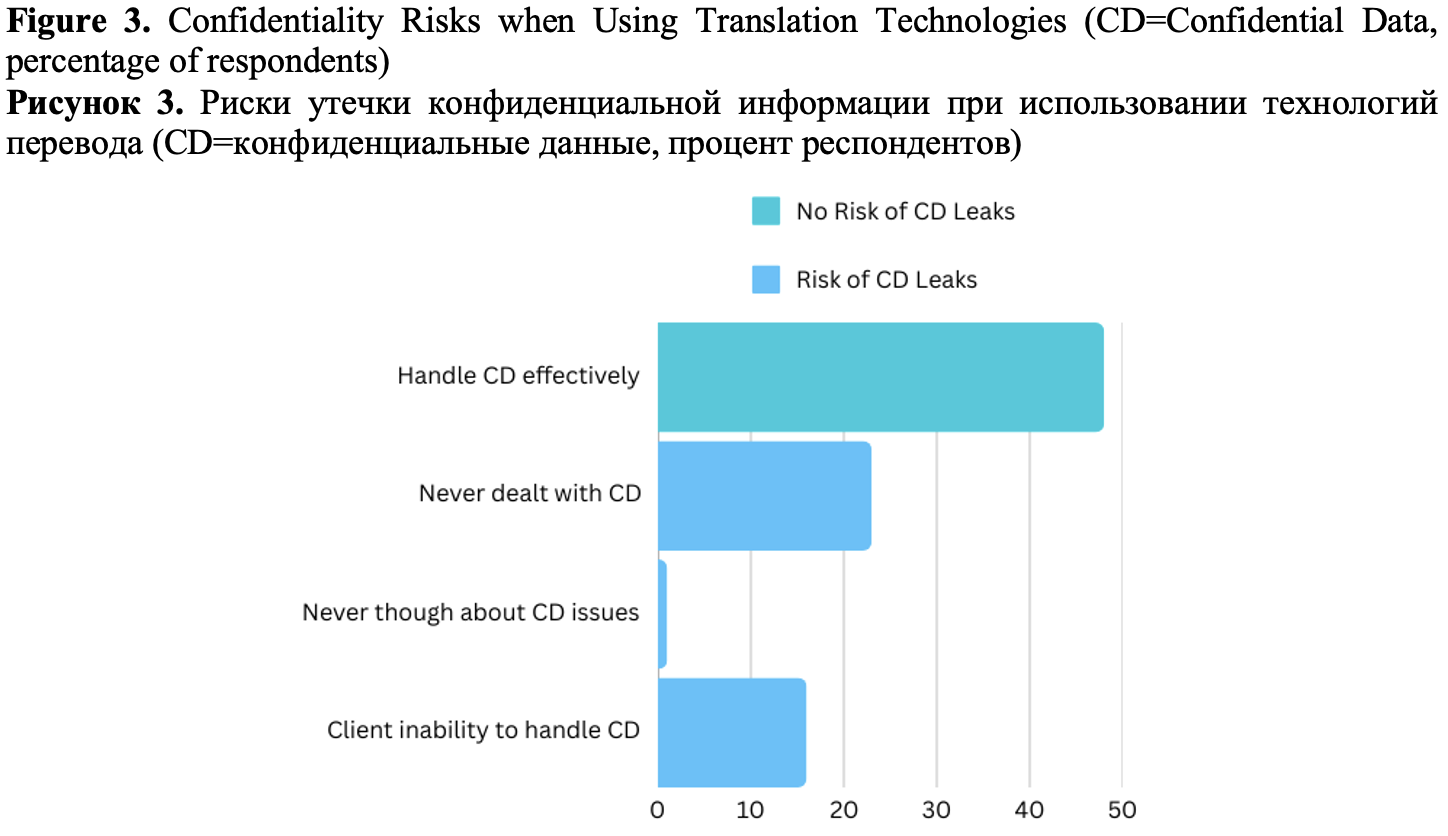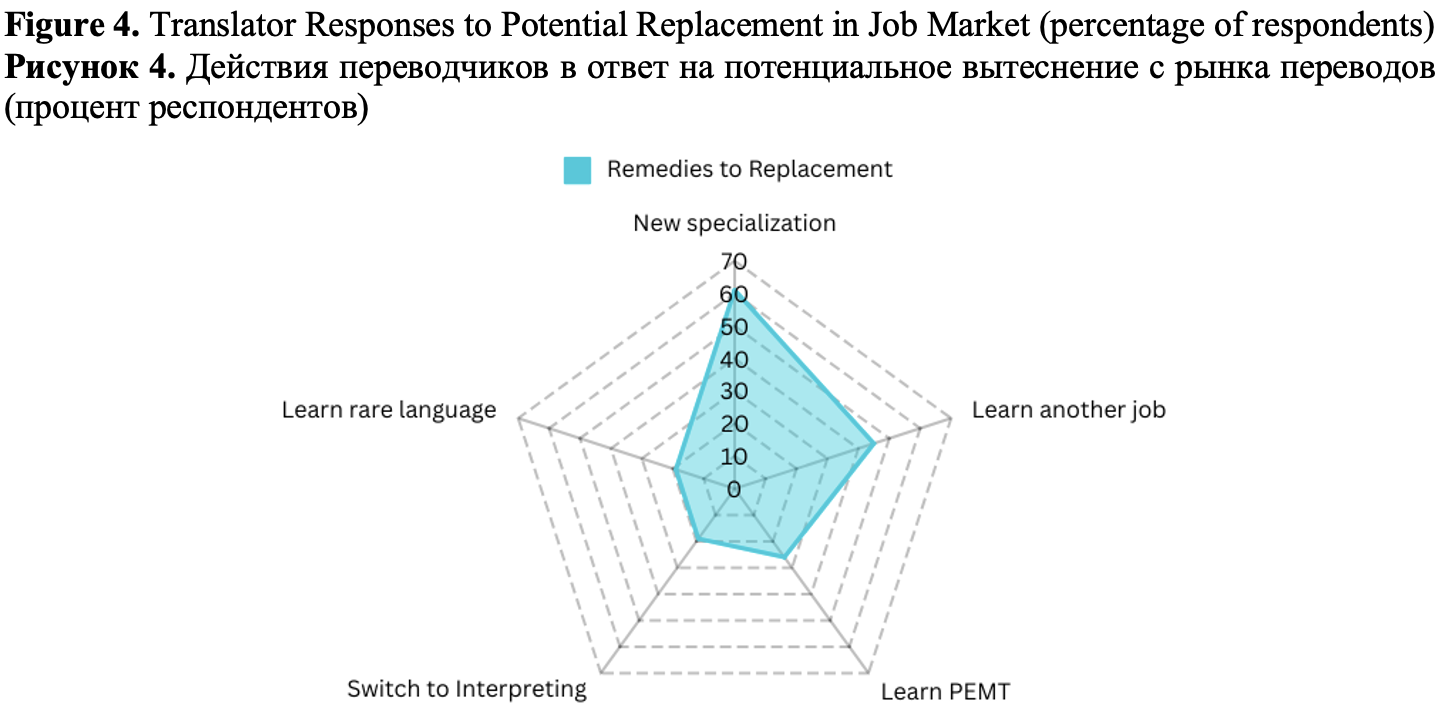Technological impact on the translation industry and beyond: perspectives of Russian translation professionals
Modern technical tools allow achieving high-quality translations in shorter time. According to some researchers and practitioners, a translator is turning into a highly qualified specialist, who is required to be proficient in the language and able to use technical tools. This phenomenon is called augmented translation by analogy with augmented reality. Undoubtedly, augmented translation becomes an everyday practice, and it will lead to massive changes in the translation market and will challenge those learning and already providing language services. The present study aims to identify the translation community's attitudes towards the changes associated with digitalization as well as the possible risks ensuing the technological developments. The research is framed as a qualitative exploration using interviews as a major tool to address the objective. Thirty-one professional translators of various ages, backgrounds, and experiences were interviewed to learn about their views on digitalization. We conclude that although the changes in the industry are significant, practicing translators demonstrate flexibility and the ability to adapt to changing conditions. That said, the implications of digitalization require an immediate response at the level of university training, translation agencies, businesses, and society at large. In general, decisions to introduce technology into the translation industry should be more balanced to avoid negative consequences for stakeholders.
Figures





Saduov, R. T., Ganeeva, E. R., Syrovatskaya, M. P. (2025). Technological impact on the translation industry and beyond: perspectives of Russian translation professionals, Research Result. Theoretical and Applied Linguistics, 11 (1), 26-49.



















While nobody left any comments to this publication.
You can be first.
Almeida, G. de and O’Brien, Sh. (2010). Analysing post-editing performance: correlations with years of translation experience, Proceedings of 14th Annual Conference of the European Association for Machine Translation, Saint-Raphaël, France, available at: https://aclanthology.org/2010.eamt-1.19.pdf (Accessed 17 November 2024). (In English)
Balashov, Yu. (2020). The Translator’s Extended Mind, Minds and Machines, 30, 349–383. https://doi.org/10.1007/s11023-020-09536-5(In English)
Balashov, Yu. (2022). The Boundaries of Meaning: A Case Study in Neural Machine Translation, Inquiry: An Interdisciplinary Journal of Philosophy, 66. https://doi.org/10.1080/0020174X.2022.2113429(In English)
Cronin, M. (2003). Translation and Globalization, Routledge, London and New York. (In English). DOI: 10.4324/9780203378816 (In English)
Dorst, A. G., Valdez, S. and Jongste, D. (2023). Professional translators’ and project managers’ perceptions of machine translation and post-editing: a survey study, Proceedings of the New Trends in Translation and Technology Conference – Nettt 2022, Rhodes Island, Greece, 50–59, available at: https://handle.net/1887/3590063 (Accessed 17 November 2024). (In English)
Elias, M. S., Smith, L. W. and Barney, E. C. (2012). Age as a moderator of attitude towards technology in the workplace: Work motivation and overall job satisfaction, Behaviour and Information Technology, 31 (5), 453–467. https://doi.org/10.1080/0144929X.2010.513419(In English)
Gaspari, F., Almaghout, H. and Doherty, S. (2015). A survey of machine translation competences: Insights for translation technology educators and practitioners, Perspectives: Studies in Translatology, 23 (3): 333–358. https://doi.org/10.1080/0907676X.2014.979842(In English)
Gaspari, F., Toral, A., Kumar, N. S., Groves, D. and Way, A. (2014). Perception vs. reality: Measuring Machine translation post-editing productivity, Proceedings of the 11th Conference of the Association for Machine Translation in the Americas, Vancouver, Canada, 60–72. (In English)
Green, S., Heer, J. and Manning, C. D. (2013). The efficacy of human post-editing for language translation, CHI ‘13 Proceedings of ACM human factors in computing systems, New York, USA, 439–448. https://doi.org/10.1145/2470654.2470718(In English)
Guerberof Arenas, A. (2014). Correlations between productivity and quality when post-editing in a professional context, Machine Translation, 28, 165–186. https://doi.org/10.1007/s10590-014-9155-y(In English)
Hohenstein, J., Kizilcec, F. R., DiFranzo, D., Aghajari, Zh., Mieczkowski, H., Levy, K., Naaman, M., Hancock, J. and Jung, F. M. (2023). Artificial intelligence in communication impacts language and social relationships, Scientific Reports, 13. Article 5487. https://doi.org/10.1038/s41598-023-30938-9(In English)
Hutchins, J. (1998). The Origins of the Translator’s Workstation, Machine Translation, 13 (4), 287–307. https://doi.org/10.1023/A:1008123410206(In English)
Jiang, Y. and Niu, J. (2022). How are neural machine-translated Chinese-to-English short stories constructed and cohered? An exploratory study based on theme-rheme structure, Lingua, 273. Article 103318. https://doi.org/10.1016/j.lingua.2022.103318(In English)
Kenny, D. (ed.) (2022). Machine translation for everyone: Empowering users in the age of artificial intelligence (Translation and Multilingual Natural Language Processing 18), Language Science Press, Berlin. DOI: 10.5281/zenodo.6653406 (In English)
Kirov, V. and Malamin, B. (2022). Are translators afraid of artificial intelligence?, Societies, 12 (2), 70. https://doi.org/10.3390/soc12020070(In English)
Koskinen, K. and Ruokonen, M. (2017). Love letter or hate mail? Translators’ technology acceptance in the light of their emotional narratives, in Kenny, D. (ed.) Human Issues in Translation Technology. Routledge, London, 8–24. (In English)
Läubli, S. and Orrego-Carmona, D. (2017). When Google translate is better than some human Colleagues, those people are no longer colleagues, Proceedings of the 39th Conference Translating and the Computer. AsLing, London, 59–69. https://doi.org/10.5167/uzh-147260(In English)
Lee, T. K. (2023). Artificial intelligence and posthumanist translation: ChatGPT versus the translator, Applied Linguistics Review, (0), available at: https://www.degruyter.com/document/doi/10.1515/applirev-2023-0122/html (Accessed 17 November 2024). https://doi.org/10.1515/applirev-2023-0122(In English)
Mesa-Lao, B. (2014). Speech-enabled Computer-Aided Translation: A satisfaction Survey with Post-editor Trainees, Workshop on Humans and Computer-assisted Translation, Association for Computational Linguistics, Gothenburg, Sweden, 99–103. DOI: 10.3115/v1/W14-0315 (In English)
Moneus, A. M. and Sahari, Y. (2024). Artificial Intelligence and human translation: A contrastive study based on legal texts, Heliyon, 10 (6), available at: https://doi.org/10.1016/j.heliyon.2024.e28106(In English)
O’Curran, E. (2014). Machine translation and post-editing for user generated content: an LSP perspective, Proceedings of the 11th Conference of the Association for Machine Translation in the Americas: MT Users Track, 50–54, Vancouver, Canada. (In English)
Pérez-Ortiz, J. A., Forcada, L. M. and Sánchez-Martínez, F. (2022). How neural machine translation works, in Dorothy, K. (ed.) Machine translation for everyone: Empowering users in the age of artificial intelligence (Translation and Multilingual Natural Language Processing 18), Language Science Press, Berlin, 141–164. DOI: 10.5281/zenodo.6653406 (In English)
Saka, E. (2024). Sosyal Fayda için Yapay Zeka, REFLEKTİF Sosyal Bilimler Dergisi, 5 (1), 85-101, available at: https://doi.org/10.47613/reflektif.2024.146 (Accessed 17 November 2024). (In Turkish)
Sánchez Torrón, M. (2017). Productivity in post-editing and in neural interactive translation prediction: A study of English-to-Spanish professional translators, PhD dissertation, University of Auckland, Auckland. (In English)
Sarker, H. I. (2021). Machine Learning: Algorithms, Real-World Applications and Research Directions, SN Computer Science, 2, 160. https://doi.org/10.1007/s42979-021-00592-x (Accessed 17 November 2024). (In English)
Zouhar, V., Popel, M., Bojar, O. and Tamchyna, A. (2021). Neural Machine Translation Quality and Post-Editing Performance, Proceedings of the 2021 Conference on Empirical Methods in Nßatural Language Processing, Online and Punta Cana, Dominican Republic. Association for Computational Linguistics, 10204–10214. DOI: 10.18653/v1/2021.emnlp-main.801 (In English)
Corpus Material
Balemans, P. (2020). The Usefulness of CAT Tools, available at: https://www.atanet.org/tools-and-technology/usefulness-cat-tools/ (Accessed17 November 2024). (In English)
Bruk, P. (2003). Translation in Russia and Market Economy, available at: http://www.utr.spb.ru/article_brouk.htm (Accessed 17 November 2024). (In Russian)
Bureau of Labour Statistics, U.S. Department of Labour (2022). Occupational Outlook Handbook, Interpreters and Translators, available at: https://www.bls.gov/ooh/media-and-communication/interpreters-and-translators.htm (Accessed 17 November 2024). (In English)
Chto zhdet perevodchikov v novom godu? [What should translators expect in the coming year?] (2021). I, Translator, available at: https://vk.com/@itranslator-chto-zhdet-perevodchikov-v-novom-godu (Accessed 17 November 2024). (In Russian)
DePalma, A. D. (2017). Augmented Translation Powers up Language Services, available at: https://csa-research.com/Blogs-Events/Blog/ArticleID/140/Augmented-Translation-Powers-up-Language-Services (Accessed 17 November 2024). (In English)
EUATC (2021): ELIS 2021 – European Language Industry Survey, available at: https://ec.europa.eu/info/sites/default/files/about_the_european_commission/service_standards_and_principles/documents/elis_2021_european_language_industry_survey.pdf (Accessed 17 November 2024). (In English)
Future of Jobs Report 2023/5. (2023). World Economic Forum, available at: https://www3.weforum.org/docs/WEF_Future_of_Jobs_2023.pdf (Accessed 17 November 2024). (In English)
Marciano J. (2021). Technology allows translators to focus on the meaning of language, available at: https://www.lengoo.com/blog/augmentedtranslation/ (Accessed 17 November 2024). (In English)
Medvedeva, O. (2022). Kak pandemiia i sanktsii povloyali na perevodchikov [How the pandemic and sanctions influenced the translators], Rossiiskaia gazeta, available at: https://rg.ru/2022/08/24/reg-urfo/bez-perevoda.html (Accessed 17 November 2024). (In Russian)
MEMSOURCE (2022). Memsource Machine Translation Report Q1 22, available at: https://www.memsource.com/uploads/2022/02/08/mt_report_q1_22.pdf (Accessed 17 November 2024). (In English)
Pielmeier, H. and Lommel, A. (2021). How Do Freelancers Use MT? Common Sense Advisory, available at: https://insights.csa-research.com/reportaction/305013347/Marketing?SearchTerms=lommel(In English)
Potekhin, A., Gerin, A. and Maslenikov, R. (2006). Rynok perevodcheskikh uslug [Translation Market Research], Adevertology. available at: http://www.advertology.ru/article27158.htm (Accessed 17 November 2024). (In Russian)
Razmer i dinamika perevodcheskogo rynka v Rossii [Size and Dynamics of Translation Market in Russia] (2020), available at: https://translationrating.ru/market-size-2020/ (Accessed 17 November 2024). (In Russian)
Reznichenko, A. (2019). Bolshee vliianie na rynok vozymeet to, naskolko Rossiia budet otkrytoi dlya mezhdunarodnoi torgovli stranoi [Whether Russia is going to remain open to international trade will significantly impact the market], available at: https://dzen.ru/media/id/5d8b27adc49f2900aed01cfd/bolshee-vliianie-na-rynok-vozymeet-to-naskolko-rossiia-budet-otkrytoi-dlia-mejdunarodnoi-torgovli-stranoi-5d8b27d298fe7900b0e3b8a0 (Accessed 17 November 2024). (In Russian)
RWS (2020). Translation technology insights 2020. RWS, available at: https://www.rws.com/localization/products/resources/translation-technology-insights-2020/ (Accessed 17 November 2024). (In English)
Sorgi, G. (2023). EU gives more power to AI translation machines. Politico, available at: https://www.politico.eu/article/ai-technology-eu-commission-parliament-gives-more-power-to-ai-translation-machines/ (Accessed 17 November 2024). (In English)
The translator, an endangered species? (2022). The UNESCO Courier, available at: https://courier.unesco.org/en/articles/translator-endangered-species?TSPD_101_R0=080713870fab20000881d7129c1c999bf9ef4f944bb1a68c507680b596266eef87e77dd0f0b3371c088526c8f914300091483db16cf982663f93de2b7056795dc0b5a6fd455324838a2553c620360547a269b710596d4314fcd02de701c5f74a (Accessed 17 November 2024). (In English)
Zetzsche, J. (2022). Is the Machine Translation Market Maturing? In American Translators Association. Available at: https://www.atanet.org/translation/is-the-machine-translation-market-maturing/ (Accessed 17 November 2024). (In English)